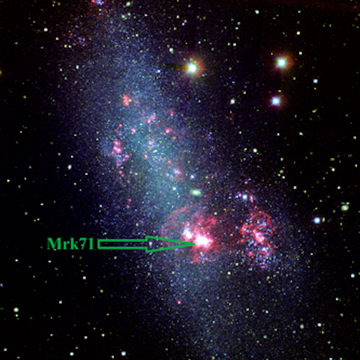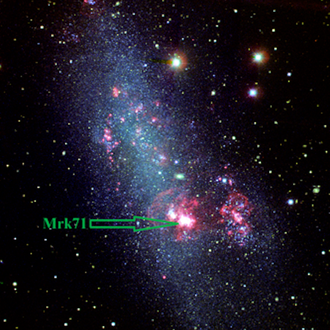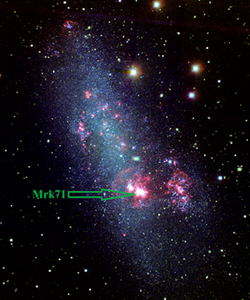Nearby galaxy shows how the young, dark Universe became illuminated

Green pea galaxy NGC 2366 resolved in thousands of blue (young) stars. Nebulae appear as red/rose areas. Mrk 71, the brightest one, is indicated by the arrow.
Credit: J. van Eymeren & A. R. López- Sánchez (ATNF)A team of astronomers found a nearby star-forming galaxy to emit energetic photons in a similar way to the first generation of galaxies. These first galaxies turned the Universe transparent, less than one billion years after the Big Bang.
Astronomers from the Leibniz Institute for Astrophysics Potsdam (AIP) have, for the first time, studied the complex mechanism of the escape of the ultraviolet light from galaxies using the Potsdam Multi- aperture Spectrophotometer (PMAS) at the Calar Alto Observatory in Spain. PMAS was developed and built at the AIP, and is in regular operation at the Calar Alto 3.5m telescope. Detailed physical analysis of the now published unique observations provide evidence for a supersonic speed outflow of gas. A similar process likely took place in the early Universe.
The Era of Reionisation
The young Universe was a dark place. A few hundred million years after the Big Bang the first stars formed, and their ultraviolet radiation ionized the hydrogen atoms that populated the Universe and absorbed the radiation. This is called the Era of Reionization, and marks the time when the Universe became transparent to light (and, hence, observable). Now, the astronomers have used the PMAS instrument to study a green pea, a local analog to the first galaxies, to better understand how ultraviolet light escapes and ionizes distant areas, in a process similar to that of Reionization. “Because of this enormous distance, we cannot observe the galaxies that hosted these first stars, even with future planned extremely large telescopes. The only thing we can do is to find local analogs to such galaxies, and study them instead of their more distant cousins. Astronomers have invented a funny name for them, green peas, because they glow in green light”, says Genoveva Micheva, astronomer at the AIP and first author of the study.
The closest green pea is NGC 2366, a dwarf galaxy somewhat irregular in shape that looks like the Large Magellanic Cloud. At a distance of only 11 million light-years away from us, NGC 2366 is close enough to be studied in detail. In its southern part lies Mrk 71, a giant nebula and two clusters of young, hot stars illuminating the gas (mostly hydrogen) around it. Such large nebular complexes are the locations of active ongoing formations of massive stars.
How Ultraviolet Light Escapes
Mrk 71 is so large that it dominates the ionization properties of the whole NGC 2366 galaxy, that is, it emits photons so energetic that they are able to remove the single electron of each atom of hydrogen around it. Energetic ultraviolet light, that astronomers think is responsible for powering the ancient epoch of Reionization, is escaping the confines of this galaxy. This light is extremely sensitive to the presence of gas and dust, which readily absorbs and scatters it. For this reason, it has thus far been unclear exactly how the energetic ultraviolet light escapes.
Studying this region with the PMAS spectrometer at the Calar Alto Observatory, Micheva and her colleagues discovered hints to a very fast biconical outflow of gas, probably caused by star forming events. The outflow starts at a young cluster of stars, tens of times more massive than the Sun, detected previously by the Hubble Space Telescope. This outflow punches a hole in the gas, which clears the way for the energetic ultraviolet light to escape from the galaxy unimpeded. “We find supporting evidence for this scenario by creating and examining spatial maps of the electron temperature and density, the speed of sound and the Mach number”, says Micheva. The average Mach number inside of Mrk 71, which represents the ratio of velocity to the speed of sound, is supersonic and increases to hypersonic outside of the core of the region. This indicates a sudden drop in gas density. “We show that this drop in density can be quite dramatic, enough to reduce the gas density to levels completely transparent to ionizing photons”, emphasizes Micheva.
It is likely that a similar process takes place in the distant Universe, where powerful outflows could puncture the dense gas of their host galaxies and hence clear the way for escape, making the Universe transparent after the “dark ages” of its beginning.
The German-Spanish Astronomical Center at Calar Alto is located in the Sierra de Los Filabres (Andalucía, Southern Spain) north of Almeria. It is operated jointly by the Max Planck Institute for Astronomy (MPIA) in Heidelberg, Germany, and the Instituto de Astrofísica de Andalucía (CSIC) in Granada/Spain. Junta de Andalucía is about to take over MPIA as a co-partner of the Calar Alto Observatory.
Further information
Original publikation
IFU investigation of possible Lyman continuum escape from Mrk 71/NGC 2366. Genoveva Micheva, Edmund Christian Herenz, Martin M. Roth, Göran Östlin, Philipp Girichidis, A&A 623 A145 (2019)
DOI: https://doi.org/10.1051/0004-6361/201834838
CAHA press release
More about PMAS

Green pea galaxy NGC 2366 resolved in thousands of blue (young) stars. Nebulae appear as red/rose areas. Mrk 71, the brightest one, is indicated by the arrow.
Credit: J. van Eymeren & A. R. López- Sánchez (ATNF)A team of astronomers found a nearby star-forming galaxy to emit energetic photons in a similar way to the first generation of galaxies. These first galaxies turned the Universe transparent, less than one billion years after the Big Bang.
Astronomers from the Leibniz Institute for Astrophysics Potsdam (AIP) have, for the first time, studied the complex mechanism of the escape of the ultraviolet light from galaxies using the Potsdam Multi- aperture Spectrophotometer (PMAS) at the Calar Alto Observatory in Spain. PMAS was developed and built at the AIP, and is in regular operation at the Calar Alto 3.5m telescope. Detailed physical analysis of the now published unique observations provide evidence for a supersonic speed outflow of gas. A similar process likely took place in the early Universe.
The Era of Reionisation
The young Universe was a dark place. A few hundred million years after the Big Bang the first stars formed, and their ultraviolet radiation ionized the hydrogen atoms that populated the Universe and absorbed the radiation. This is called the Era of Reionization, and marks the time when the Universe became transparent to light (and, hence, observable). Now, the astronomers have used the PMAS instrument to study a green pea, a local analog to the first galaxies, to better understand how ultraviolet light escapes and ionizes distant areas, in a process similar to that of Reionization. “Because of this enormous distance, we cannot observe the galaxies that hosted these first stars, even with future planned extremely large telescopes. The only thing we can do is to find local analogs to such galaxies, and study them instead of their more distant cousins. Astronomers have invented a funny name for them, green peas, because they glow in green light”, says Genoveva Micheva, astronomer at the AIP and first author of the study.
The closest green pea is NGC 2366, a dwarf galaxy somewhat irregular in shape that looks like the Large Magellanic Cloud. At a distance of only 11 million light-years away from us, NGC 2366 is close enough to be studied in detail. In its southern part lies Mrk 71, a giant nebula and two clusters of young, hot stars illuminating the gas (mostly hydrogen) around it. Such large nebular complexes are the locations of active ongoing formations of massive stars.
How Ultraviolet Light Escapes
Mrk 71 is so large that it dominates the ionization properties of the whole NGC 2366 galaxy, that is, it emits photons so energetic that they are able to remove the single electron of each atom of hydrogen around it. Energetic ultraviolet light, that astronomers think is responsible for powering the ancient epoch of Reionization, is escaping the confines of this galaxy. This light is extremely sensitive to the presence of gas and dust, which readily absorbs and scatters it. For this reason, it has thus far been unclear exactly how the energetic ultraviolet light escapes.
Studying this region with the PMAS spectrometer at the Calar Alto Observatory, Micheva and her colleagues discovered hints to a very fast biconical outflow of gas, probably caused by star forming events. The outflow starts at a young cluster of stars, tens of times more massive than the Sun, detected previously by the Hubble Space Telescope. This outflow punches a hole in the gas, which clears the way for the energetic ultraviolet light to escape from the galaxy unimpeded. “We find supporting evidence for this scenario by creating and examining spatial maps of the electron temperature and density, the speed of sound and the Mach number”, says Micheva. The average Mach number inside of Mrk 71, which represents the ratio of velocity to the speed of sound, is supersonic and increases to hypersonic outside of the core of the region. This indicates a sudden drop in gas density. “We show that this drop in density can be quite dramatic, enough to reduce the gas density to levels completely transparent to ionizing photons”, emphasizes Micheva.
It is likely that a similar process takes place in the distant Universe, where powerful outflows could puncture the dense gas of their host galaxies and hence clear the way for escape, making the Universe transparent after the “dark ages” of its beginning.
The German-Spanish Astronomical Center at Calar Alto is located in the Sierra de Los Filabres (Andalucía, Southern Spain) north of Almeria. It is operated jointly by the Max Planck Institute for Astronomy (MPIA) in Heidelberg, Germany, and the Instituto de Astrofísica de Andalucía (CSIC) in Granada/Spain. Junta de Andalucía is about to take over MPIA as a co-partner of the Calar Alto Observatory.
Further information
Original publikation
IFU investigation of possible Lyman continuum escape from Mrk 71/NGC 2366. Genoveva Micheva, Edmund Christian Herenz, Martin M. Roth, Göran Östlin, Philipp Girichidis, A&A 623 A145 (2019)
DOI: https://doi.org/10.1051/0004-6361/201834838
CAHA press release
More about PMAS
Images
Green pea galaxy NGC 2366 resolved in thousands of blue (young) stars. Nebulae appear as red/rose areas. Mrk 71, the brightest one, is indicated by the arrow.



